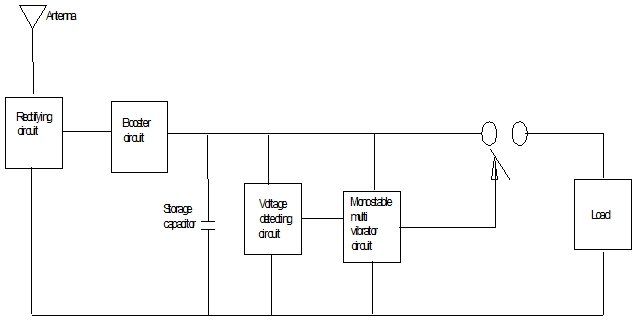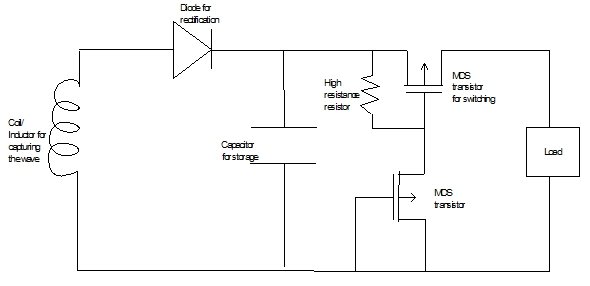Introduction
Radio wave technology is the use of airwaves in transmitting and receiving information. It is the foundation of most of our communication in the present day. Radio waves fall under the group of waves termed electromagnetic radiation, which travel at the speed of light (3×108 m/s).
These types of waves (including light, infrared, microwaves and x-rays) are classified based on their wavelengths and frequencies. The frequencies of radio waves lie between 300GHz to 3 kHz with wavelengths of 1mm to 100km. Some of the communication equipments that use radio waves include satellite dishes, radar, radios, television, mobile phones and wireless internet.
The use of radio waves for powering electronic devices had not been exploited due to the nature of waves to weaken and dissipate as they spread due to their interaction with other waves and matter. Recently, a growing interest in alternative sources of energy that could provide efficient power in remote and sensitive locations has led to research into radio wave power generation.
This paper looks at the history of radio waves and how power can be generated from them and how it can be applied in electronic devices.
History and growth of radio wave technology
The history of radio waves as medium for transmitting information started way back in the 1860s when James Clerk Maxwell, a physicist from Scotland, envisaged the existence of the waves.
His prediction was enhanced in 1886 by Heinrich Rudolph Hertz, a German physicist, who went a notch further to show how variation of electric current could be sent into space as radio waves (Bellis 3). He was able to generate and compute the first waves by using an oscillator for transmitting the waves and a metal loop for detecting them (Parker 3).
In 1895 Guglielmo Marconi, from Italy, sent a radio signal over a distance of 100m and received it. He used crafted antenna, transmitter, and condenser and had connections on the ground that could receive the signals. He also sent a wireless signal across the English Channel in 1899(Bellis 5), a distance of 3.5 miles. In addition, Nikola Tesla helped in developing and enhancing wireless radio transmitters.
Ships started using wireless telegraphy for sending distress calls while at sea. In 1899, the U.S Army adopted the wireless system and in 1901, the Navy also adopted the system. Lee Deforest invented the space telegraph in the early 1900s where amplifiers were used to strengthen weak signals (Bellis 12).
Marconi was able to transmit voice in 1914 over a distance of 50 miles (Bellis 12). Over time, many people aided in developing and enhancing radio wave communication and today we have 4G technologies that send information at very high speeds, besides audio and video streaming.
Power generation using radio waves
Electromagnetic radiation and photons
Electromagnetic waves can be said to have an atomic structure and can either generate or expend energy (“Electromagnetic waves” par. 7). The electromagnetic radiation, in quantum terms, is said to have photons transporting energy (Joules). A single photon has energy equal to hf.
E = hf h is Planck’s constant =6.626×10-34 J s and f =frequency of photon
E hf/λ v is the velocity of light= 3×108 m/s and λ =wavelength of photon
Collection of radio waves energy
Radio wave energy can be collected and harnessed using various equipments and components. The generation circuit has components such as antenna, capacitors, diodes, transistors, inductors and resistors. The antenna is used for receiving the electromagnetic signal. This signal received is then rectified. The rectifying circuit is made of diodes. Once the signal has been rectified, it is boosted before being stored in capacitors. The power stored is used to drive a load or resistor via a switching circuit.


MOS transistors are used for switching or controlling the stored power to the load. The source of the MOSFET (for switching) is connected to the storage capacitor with the drain connected to the load. The link between the capacitor and load is created when the voltage of the stored charge is equivalent to the sum of the threshold voltages of both MOSFETs (Ishida et al. 4).
Potential of radio wave harvesting
Radio wave energy can be efficiently and sufficiently harvested if various factors are considered. These are:
- Using powerful receivers which detect a wide range of frequencies as well as arresting a high concentration of the wasted waves
- Ensuring energy is obtained at low power density from sensors located far-off from the source for energy obtained varies inversely with distance (1/d2)
- Ensuring the voltage generated from the source is greater than 0.3V (1 milliwatt) for satisfactory conversion of all incoming wave
- Using high quality circuits and transistors
Applications of the power generated using radio waves
Power generated by radio waves is quite small ranging from a few microwatts to hundreds of milliwatts. The power generated can be used in devices such as:
- LED monitor lights.
- Sensors.
- LCD display thermometer.
- Implants in the biomedical field.
- Charging the battery for cell phones.
- Safety hard hat.
Possibility of radio waves technology replacing batteries
Nowadays, there is a high requirement for efficient energy sources. Furthermore, the sources should be mobile and flexible. Batteries are usually bulky, require regular maintenance and have a limited life and as such require constant replacement. With the rapid advancement in technology where electronic gadgets and devices are continually made smaller and efficient, their energy requirements have decreased over time.
Proper harnessing of radio wave energy could provide an alternative source of energy for powering small electrical devices such as sensors. This is through capturing the electricity produced by the radio waves and is depended on how far the transmitter is and the magnitude of the power generated by the transmitter.
The power that can be harnessed from these waves is in the range of microwatts to milliwatts which can be sufficient for powering the devices especially in remote locations. Thus, there is a possibility of radio waves technology replacing batteries.
Conclusion and personal thought about radio wave technology application in future
Energy harnessed from wasted radio waves is small. This energy may not be adequate to power large electronic devices but technology has been changing very rapidly in the recent years. Many companies are developing gadgets that are very small, thus requiring less power. For example, the mobile phone industry has seen a reduction in the size of the phones but with more installed phone features and applications.
Nokia has come up with a harvesting device embedded in a cell phone. This device is able to charge the phone’s battery (Dixon 3). This means that in the future, many miniature gadgets will have been developed which will totally rely on radio frequency energy. Furthermore, radio wave energy will provide a reliable source of energy since the use of cell phones, television, radios and other communication devices is on the rise.
Works Cited
Bellis, Mary. The Invention of Radio. 2012. Web.
Dixon, Bryn. Radio Frequency Energy Harvesting. 2010. Web.
Electromagnetic Waves. 2010. Web.
Ishida, Makoto, Kazuaki Sawada, Hidekuni Takao, and Minoru Sudo. Power Generation Circuit using Electromagnetic Wave. 2011. Web.
Parker, Bev. The History of Radio. Web.